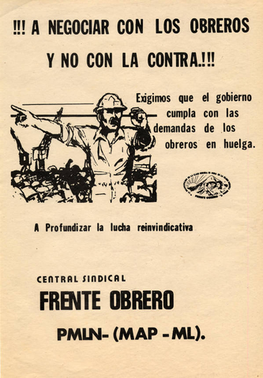Related Research Articles

The Farabundo Martí National Liberation Front is a Salvadoran political party and former guerrilla rebel group.
Coordinadora Revolucionaria de Masas was a coordination of revolutionary mass organizations in El Salvador formed on January 11, 1980.

The Labor Party is a political party in Mexico. It was founded on 8 December 1990. The party is currently led by Alberto Anaya.
The Xinka, or Xinca, are a non-Mayan indigenous people of Mesoamerica, with communities in the southern portion of Guatemala, near its border with El Salvador, and in the mountainous region to the north.
The civil unrest in San Salvador Atenco of 2006 began on Wednesday, May 3, when police prevented a group of 60 flower vendors from selling at the Texcoco local market in the State of México, about 30 km (19 mi) from Mexico City. State police used violence and arrest against resisters. The flower vendors appealed to the residents of San Salvador Atenco, a small neighboring community about 25 km (16 mi) northeast of Mexico City, famous for creating their resistance organization against the development of an airport on their land in 2002.
San Salvador Atenco is the municipal seat of Atenco, in the Mexican state of Mexico. The name "Atenco" comes from a Nahuatl phrase meaning "place on the edge of water".

Texcoco de Mora is a city located in the State of Mexico, 25 km northeast of Mexico City. Texcoco de Mora is the municipal seat of the municipality of Texcoco. In the pre-Hispanic era, this was a major Aztec city on the shores of Lake Texcoco. After the Conquest, the city was initially the second most important after Mexico City, but its importance faded over time, becoming more rural in character. Over the colonial and post-independence periods, most of Lake Texcoco was drained and the city is no longer on the shore and much of the municipality is on lakebed. Numerous Aztec archeological finds have been discovered here, including the 125 tonne stone statue of Chalchiuhtlicue, which was found near San Miguel Coatlinchán and now resides at the Museum of Anthropology in Mexico City.

Frente Obrero (FO) was a national trade union centre in Nicaragua. It was founded c. 1972-74, as the trade union wing of the MAP-ML.

The University of El Salvador or Universidad de El Salvador (UES) is the oldest and the most prominent university institution in El Salvador. It serves as the national university of the country. The main campus, Ciudad Universitaria, is located in the capital of San Salvador, but there are also branches of the university in other Salvadoran cities such as Santa Ana, San Miguel and San Vicente. The university counts a total of 9 faculties in its main campus and has a student population of more than 50,000.
Santa Isabel Ixtapan is a community which is part of the municipality of San Salvador Atenco in the State of Mexico, Mexico. It has 4,125 inhabitants and lies 2,240 meters above sea level.

Pilón Lajas Biosphere Reserve and Communal Lands is a protected area in Bolivia located in the departments of La Paz and Beni, in their northern and western parts, respectively, about 350 km northeast of La Paz and 50 km west of San Borja. It lies largely within the Bolivian Yungas ecoregion. The main river that flows in the Pilon Lajas area is the Quiquibey River.
El Pueblo was a revolutionary newspaper published in Nicaragua. El Pueblo was the organ of Frente Obrero, the trade union wing of the Marxist–Leninist Popular Action Movement (MAP-ML). The newspaper began publication in March 1979.

Felipe Ángeles International Airport, also known as Mexico City Felipe Ángeles International Airport or simply Mexico City-AIFA, is an international airport located in Zumpango, State of Mexico, 35 kilometres (22 mi) north of Mexico City. Originally named Santa Lucía Air Force Base, it opened for civilian use in 2022, serving as the second airport for Greater Mexico City. The passenger terminal facilitates domestic and international flights, functioning as a Focus City for Viva Aerobus and Aeroméxico Connect. It is the main hub for Mexicana, a state-owned airline. Apart from civilian operations, the airport accommodates the Mexican Air Force, general aviation, and charter flight services.
The Escuela Preparatoria Tlalpan II "Otilio Montaño" is a senior high school in San Miguel Topilejo, Tlalpan, Mexico City. It is within the Instituto de Educación Media Superior del Distrito Federal (IEMS).

Mexico City Texcoco Airport was a planned airport in Mexico City that was meant to become Mexico's New International Airport. The project was announced in September 2014 but was canceled in late 2018 after a referendum was held stating that the new airport should be built at a different location due to how close it was to close housing, rising cost and a geographical issue with the site. Felipe Ángeles International Airport opened in March 2022.

Matilde Rodríguez Cabo Guzmán was Mexico's first female psychiatrist. Also a surgeon, writer, feminist, and suffragist, Rodríguez was an activist for the right of Mexican women, and affiliated with the Mexican Communist Party. She was married to General Francisco J. Múgica; they had a son, Janitzio Múgica Rodríguez Cabo.
The Autopista Toluca–Naucalpan is a 39-kilometre (24 mi) toll road under construction in Greater Mexico City which will connect Toluca in the west with Naucalpan in the east, meeting the Autopista Chamapa–Lechería.
The Camino Real in New Mexico was the northern part of a historic roadway known as the Camino Real de Tierra Adentro that from 1598 ran from Mexico City northward through central and northern Mexico and the Trans-Pecos part of what is now Texas to San Juan Pueblo in Santa Fe de Nuevo Mexico, now the state of New Mexico.

Leonardo Grosso is an Argentine politician. Grosso is a member and one of the most prominent faces of the Evita Movement, a peronist political and social organization. He was a member of the Argentine Chamber of Deputies for Buenos Aires Province for 12 years, from 2011 to 2023.